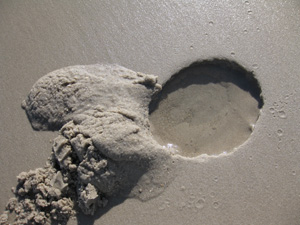The sands at the edge of the sea are something that most visitors to LBI, and in many places along the Jersey shore, take for granted. These wonderful ribbons of sand along the coast are much different than the rocky coastline found just north along the shores of New England. Why are these sands here and where did they come from? Is there anything special about sand?
Origins

The Appalachian mountains serve as the source for much of the sand we find in LBI, The grains on our beaches are mostly quartz. The sand represent the weathering of rock that has taken place over long periods of time. Rain, landslides, ice, cycles of freezing and thawing, and more all take their toll and have broken up, and explosed, mountain rocks. As these break into smaller pieces they make their way into and transported by transported water ways. Swifter moving water moves larger pieces of rock. These grind along and break up into smaller pieces. Eventually these waterways and the rock grains they hold all drain into the sea. The deposition of these materials build up along the coast, as they drop out of what were swifter and forward moving streams and rivers.
Piles of Sand
The sands you see on the beach have been moved by water and wind. Ligher exposed grains of sand are blown about, as anyone who has been on the beach on a windy day knows. Over time more sand is blown to the back of the beach and forms sand dunes. This is countered by the water lapping at the beach, which somtimes deposits sand and at other times moves sand away. During very high tides and strong storms the water will pull much a lot more sand back into the water. The dunes then serve as a source of natural replenishment for the sand that has been pulled back. Slowly over the course of a season or many season, sand that was pulled into the water can be brought back onto the beach. This will then begin the process of adding more sand to both the beach and, in turn, the dunes. You can learn more about beach sand movement here
The nature of a Sand Grain
Each sand grain has been battered and beaten from a larger rock (see origins above). Interestingly, once it is the size of a sand grain it is fairly stable. If it is in the water or along the shore where the waves are crashing, each grain has a small film of water surrounding it. They also lie closely to other grains that also have the same film held tightly to their surface by capillary action. This water acts as a cushion that prevents even heavy blows from doing any damage to the grain. The water film also acts as a barrier to the grains adhering strongly to one another, at least in cases where no other binding agents are present (like oil).

The grains that are in the water or regularly washed over by waves at the shoreline, not being bound to one another, serve as an interesting habitat for a whole world of small organisms. They live a very different life than most animals we usually see. These organisms are either so small they live between the grains or are larger but are able to effectively slip through the sand grains. The water coating the sands provides a means of easing their their movements, much as fish are able to swim through water. This so called interstitial (living within) fauna is found just offshore, in the sands being washed by the waves and, during low tide, just under the drying surface sands exposed by low water.
